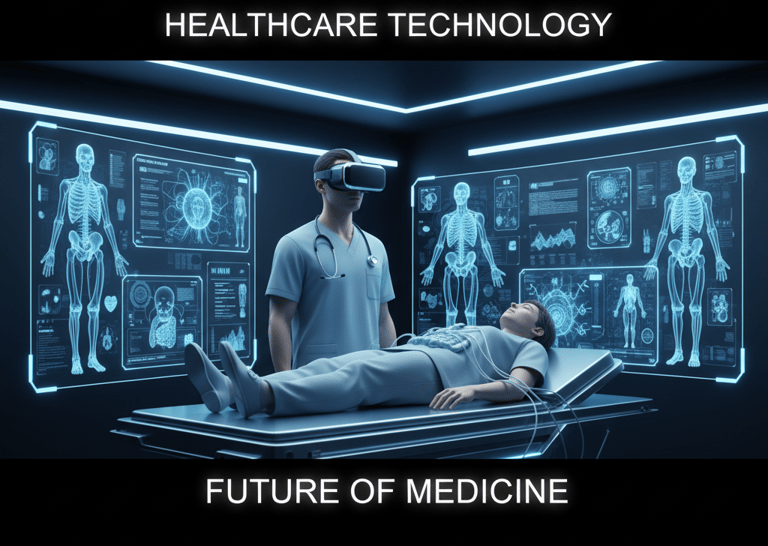VR in Healthcare: Benefits and Real-World Uses
Discover how Virtual Reality (VR) is transforming the healthcare industry — from medical training and patient therapy to surgical simulations and mental wellness. Explore real-world examples of VR in hospitals and clinics.
THE FUTURE OF VIRTUAL REALITY
Viral Gala
10/24/20252 min read


💊🏥 Virtual Healing: VR in Healthcare—Benefits and Real-World Uses
Virtual Reality (VR) is not just a tool for entertainment or gaming; it is a profound technology that is revolutionizing healthcare worldwide. From enhancing medical training to providing drug-free pain management and powerful rehabilitation, VR is becoming an essential, life-changing tool in modern medicine.
By simulating highly realistic 3D medical scenarios, VR allows doctors, students, and patients to interact safely, effectively, and compassionately with complex medical challenges.
1. Medical Training and Education
VR provides medical students and professionals with an invaluable, risk-free platform to practice surgeries and master delicate procedures.
Example: Surgeons routinely use high-fidelity VR simulators to rehearse complex, rare, or unique operations before ever performing them on a real patient.
Benefit: Dramatically enhances skill, precision, and confidence, leading to better preparedness and zero risk to patient safety during the learning process. (Explore the applications and benefits of VR in medicine on Wikipedia).
2. Pain Management and Non-Pharmacological Therapy
VR has shown remarkable results in distraction-based pain reduction during treatments, often reducing the need for heavy painkillers.
Mechanism: Patients immersed in calming virtual environments experience profound distraction and relaxation, which effectively modulates pain perception by hijacking the brain’s attention.
Example: Burn victims undergoing painful wound care use VR headsets to enter tranquil, virtual worlds, significantly easing the sensation of pain.
3. Mental Health and Psychological Therapy
VR offers powerful new methods for safely treating debilitating conditions like anxiety, phobias (e.g., arachnophobia), and Post-Traumatic Stress Disorder (PTSD) through controlled exposure therapy.
Example: A patient with a severe fear of flying can experience virtual flight scenarios—turbulence, takeoff, landing—in a safe, controlled environment to gradually desensitize and overcome their fear.
Benefit: Sessions are highly customizable, repeatable, and measurable, offering a superior, targeted therapeutic experience. (Read a community discussion on VR for pain management and mental health on Reddit).
4. Physical Rehabilitation and Recovery
VR-guided exercise programs make the arduous process of physical rehabilitation more engaging and motivating for patients recovering from strokes, injuries, or surgeries.
Example: Interactive VR games encourage precise limb movement, balance, and coordination, transforming repetitive exercises into goal-oriented challenges.
Benefit: Greatly motivates patients to stick with their rehabilitation plans, often leading to faster and more effective recovery outcomes.
5. Surgical Planning and Visualization
VR enables surgeons to use precise 3D virtual models of patient-specific organs or body parts to plan operations with millimeter accuracy.
Example: Doctors can use VR visualizations to view a tumor’s exact location, relationship to vital structures, and optimal access path before the first incision.
Benefit: Results in better pre-operative preparation, reduced surgery time, fewer complications, and significantly improved patient outcomes.
6. Patient Education and Trust
Explaining complex medical conditions to patients is made easier, clearer, and less frightening through VR visualization.
Example: A cardiologist can use VR to show a patient exactly how blood flows through their heart, where a blockage occurs, or how a medical device will function.
Benefit: Improves patient comprehension, increases adherence to treatment plans, and builds essential trust in the medical care provider.
🌟 Conclusion: The Future of Compassionate Medicine
VR in healthcare is no longer futuristic—it is happening now, improving lives and redefining what’s possible in medicine. This technology allows for treatments that are more precise, more personalized, and fundamentally more patient-friendly.
At 360 VR Photography, we specialize in creating the high-fidelity 360° and VR content—from detailed anatomical models to immersive calming environments—that powers these revolutionary solutions.
Ready to bring immersive technology to your medical or educational institution?
Contact Viral Gala: 9920322366 Explore Our VR Services: 360vrphotography.com or 360vrphotography.in.

Experience
Engaging virtual tours for real estate and events.
Innovative
info@360vrphotography.in
+91 9920322366
